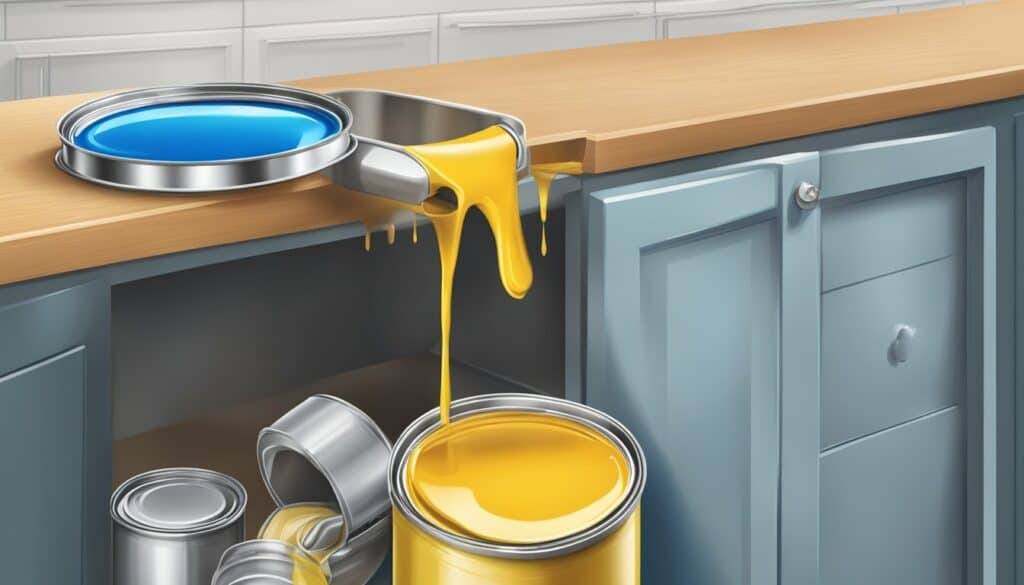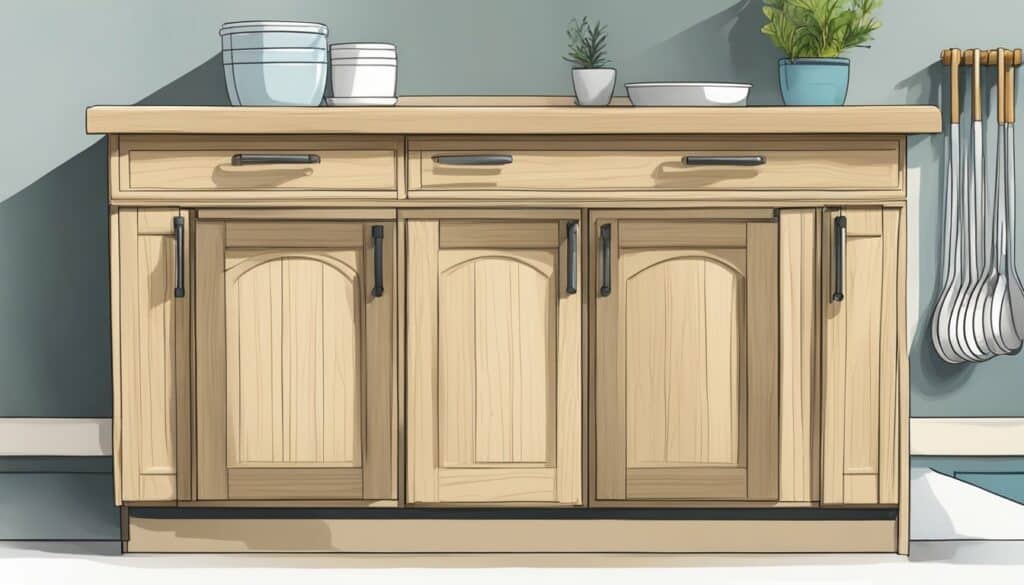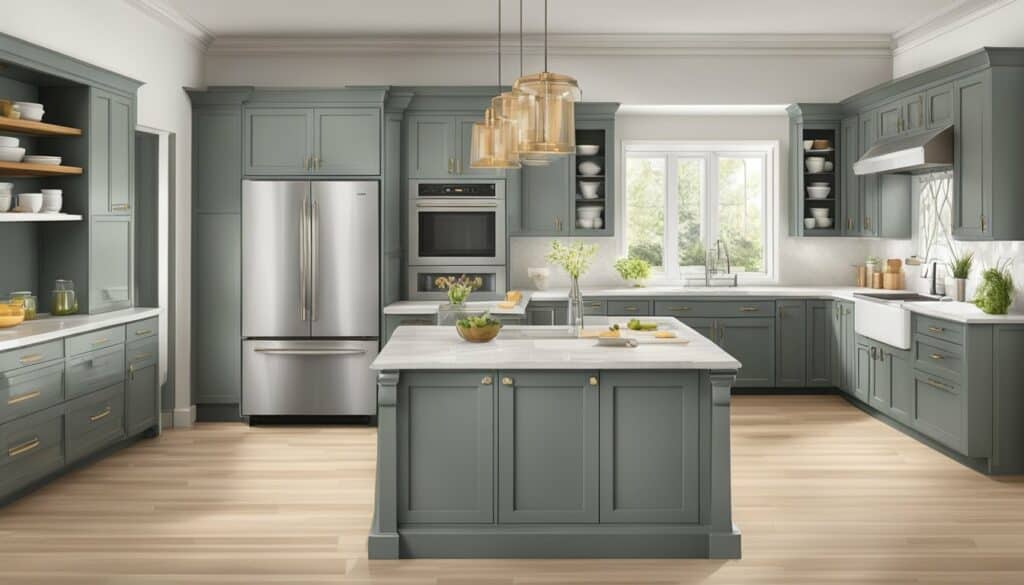Painting kitchen cabinets is a cost-effective way to give your kitchen a fresh new look. However, the process of sanding cabinets before painting can be a daunting task.
Luckily, there are now paints available that allow you to skip the sanding step altogether. In this article, we will take a look at the best paints for kitchen cabinets without sanding.

One of the best paints for kitchen cabinets without sanding is DecoArt Satin Enamel Cabinet Paint. With this paint, you don’t need to strip or sand your cabinets before painting. It provides a smooth, durable finish that is resistant to chipping and peeling. This paint is also easy to clean and comes in a variety of colors to match your kitchen decor.
Another great option is the Benjamin Moore Advance Interior Satin Paint. This paint is self-leveling, which means that it will fill in any imperfections on your cabinets, giving them a smooth, professional look. It is also durable and easy to clean, making it perfect for high-traffic areas like the kitchen. With its low VOC formula, it is also environmentally friendly.
Understanding the Need to Paint Kitchen Cabinets Without Sanding

When it comes to updating the look of a kitchen, painting the cabinets is a popular and cost-effective option. However, the thought of sanding down all of the cabinets can be daunting, especially for those who are not experienced with DIY projects. That’s where painting kitchen cabinets without sanding comes in.
The need to paint kitchen cabinets without sanding arises from the desire to save time and effort. Sanding down cabinets is a time-consuming and messy process, and it requires a lot of physical effort. For those who want to update their kitchen quickly and easily, painting without sanding is a great option.
Another reason to paint kitchen cabinets without sanding is to avoid damaging the cabinets. Sanding can be rough on the wood, and it can leave scratches and dents that will be visible even after painting. By skipping the sanding step, homeowners can preserve the integrity of their cabinets and still achieve a beautiful, updated look.
Painting kitchen cabinets without sanding is also a great option for those who want to avoid using harsh chemicals. Sanding often requires the use of chemical strippers, which can be dangerous to work with and can damage the environment. By painting without sanding, homeowners can avoid using these chemicals and still achieve a beautiful finish.
Overall, the need to paint kitchen cabinets without sanding arises from the desire to save time and effort, avoid damaging the cabinets, and avoid using harsh chemicals. With the right tools and techniques, painting kitchen cabinets without sanding can be a quick and easy way to update the look of a kitchen.
Types of Paint Suitable for Kitchen Cabinets

When it comes to painting kitchen cabinets without sanding, there are a few types of paint that are suitable for the job. The best paint for kitchen cabinets is one that is durable, easy to clean, and resistant to chipping and peeling.
One type of paint that is commonly used for kitchen cabinets is latex paint. Latex paint is water-based and dries quickly, making it a popular choice for DIY projects. It is also easy to clean up with soap and water. However, regular latex paint may not hold up well in high-traffic areas like the kitchen, so it is important to choose a high-quality latex paint specifically designed for cabinets.
Another type of paint that is suitable for kitchen cabinets is chalk paint. Chalk paint has a matte finish and is easy to distress, giving cabinets a vintage or shabby chic look. However, chalk paint may not be as durable as other types of paint, so it is important to seal it with a clear wax or polyurethane.
Oil-based paint is another option for painting kitchen cabinets. Oil-based paint is durable and provides a smooth, glossy finish. However, it takes longer to dry and requires mineral spirits for clean up. It is also important to note that oil-based paint emits strong fumes, so proper ventilation is necessary.
Enamel paint is a type of oil-based paint that is specifically designed for use on cabinets and other high-traffic areas. Enamel paint provides a hard, durable finish that is resistant to chipping and peeling. However, like other oil-based paints, it emits strong fumes and requires mineral spirits for clean up.
In conclusion, there are several types of paint that are suitable for painting kitchen cabinets without sanding. The best type of paint will depend on the homeowner’s preferences and needs. Whether they choose latex paint, chalk paint, oil-based paint, or enamel paint, the end result will be a fresh, updated look for their kitchen cabinets.
Best Paint Brands for Kitchen Cabinets
When it comes to painting kitchen cabinets, choosing the right paint brand is crucial. Not all paints are created equal, and using the wrong one can lead to a less-than-perfect finish or even damage to your cabinets. Here are some of the best brands of paint for kitchen cabinets that are worth considering:
- Benjamin Moore: This popular brand offers a range of cabinet paints, including their Advance line, which is a waterborne alkyd paint that dries to a hard, durable finish. It is also self-leveling, which means it will help hide brush marks and other imperfections.
- Sherwin-Williams: Another well-known brand, Sherwin-Williams offers their Emerald Urethane Trim Enamel for cabinets. This paint is known for its durability and resistance to chipping, fading, and yellowing.
- Behr: Behr’s Urethane Alkyd Semi-Gloss Enamel is a great choice for those on a budget. It provides a smooth, durable finish that is resistant to stains and scuffs.
- Valspar: Valspar’s Cabinet Enamel is a high-quality paint that is specifically designed for cabinets. It dries to a hard, durable finish and is resistant to chipping, peeling, and fading.
- Rust-Oleum: Rust-Oleum’s Cabinet Transformations Kit is a unique option that includes a bonding coat, decorative glaze, and protective topcoat. It is easy to apply and provides a smooth, durable finish.
When choosing a paint brand, it’s important to consider factors such as durability, ease of application, and resistance to stains and scratches. It’s also a good idea to choose a paint with a low sheen, as this will help hide imperfections and make cleaning easier. With the right paint brand and a little bit of effort, you can transform your kitchen cabinets and give your kitchen a fresh, new look.
Preparation Before Painting
Before starting to paint the kitchen cabinets, it is essential to prepare the surfaces properly to ensure a smooth and long-lasting finish. This section will cover the necessary steps to take before painting the cabinets without sanding.
Firstly, remove the cabinet doors and take off any hardware to avoid drips and unnecessary mess. It is best to lay the cabinet door flat on the ground or a workbench for painting.
Next, clean the surfaces thoroughly with a degreaser to remove any dirt, grease, or grime. A mixture of warm water and dish soap or a commercial degreaser can be used for this purpose. Rinse the surfaces with clean water and let them dry completely.
After cleaning, it is advisable to apply a liquid sander/deglosser to the surfaces. This product helps to remove the gloss finish and roughen up the surface, allowing the paint to adhere better. Follow the manufacturer’s instructions carefully when using this product.
Once the surfaces are dry, it is time to apply a bonding primer. This type of primer is specially formulated to stick to glossy surfaces and provide a good base for the paint. Apply the primer with a 2″ synthetic brush in the direction of the grain, making sure to smooth out any drips on edges before they dry.
Finally, make sure the paint you choose is suitable for kitchen cabinets and apply it in thin, even coats. It is better to apply several thin coats than one thick coat to avoid drips and ensure proper coverage. Allow each coat to dry completely before applying the next one.
By following these steps, the cabinet doors will be ready to paint, and the finished result will be smooth and long-lasting.
Effective Ways to Paint Your Kitchen Cabinets
Painting kitchen cabinets is a great way to give your kitchen a fresh new look, without having to spend a lot of money on a full renovation. However, the process of painting cabinets can be time-consuming and messy, especially if you need to sand them first. Fortunately, there are effective ways to paint your kitchen cabinets without sanding, making the process much easier and less messy.
One way to paint your cabinets without sanding is to use a deglosser. A deglosser is a liquid that removes the glossy finish from the cabinets, allowing the paint to adhere better. Simply apply the deglosser to the cabinets, let it sit for the recommended amount of time, and then wipe it off with a clean cloth. Once the cabinets are dry, you can paint them with your chosen paint.
Another effective way to paint your kitchen cabinets without sanding is to use a bonding primer. A bonding primer is a special type of primer that helps paint adhere to surfaces that are difficult to paint, such as cabinets. Simply apply the bonding primer to the cabinets, let it dry, and then paint them with your chosen paint.
When it comes to choosing the best paint for kitchen cabinets, there are several factors to consider. First, you want to choose a paint that is durable and will hold up well over time. Look for a paint that is specifically designed for cabinets, as these paints are typically more durable and long-lasting.
You also want to choose a paint that is easy to clean, as kitchen cabinets can get dirty quickly. Look for a paint that is easy to wipe clean with a damp cloth, and that won’t chip or peel easily.
In addition, you want to choose a paint that is the right color and finish for your kitchen. Consider the overall style and color scheme of your kitchen, and choose a paint that complements it well. You also want to choose a finish that is appropriate for your cabinets; a semi-gloss or high-gloss finish is typically best for kitchen cabinets, as it is easy to clean and durable.
Overall, there are several effective ways to paint your kitchen cabinets without sanding, and choosing the right paint is key to achieving a beautiful and long-lasting finish.
Painting Specific Types of Cabinets
When it comes to painting kitchen cabinets without sanding, there are some specific types of cabinets that require a bit of extra attention. Whether you’re dealing with oak cabinets, laminate cabinets, or oak kitchen cabinets, there are a few things you should keep in mind to ensure that your painting project is a success.
For oak cabinets, it’s important to choose a paint that will adhere well to the wood grain. Look for a paint that is specifically designed for use on wood surfaces, and consider using a primer to help the paint stick. If you’re painting over an existing finish, make sure to clean and degloss the surface first to ensure that the paint will adhere properly.
Laminate cabinets can be a bit trickier to paint, as the slick surface can be difficult for paint to stick to. Look for a paint that is specifically designed for use on non-porous surfaces, and consider using a bonding primer to help the paint adhere. It’s also a good idea to lightly sand the surface with a fine-grit sandpaper to help the paint stick.
When it comes to oak kitchen cabinets, the same rules apply as with regular oak cabinets. However, it’s important to take extra care when painting the doors and drawers, as these surfaces are often handled frequently and can be prone to chipping and peeling. Consider using a durable paint and applying multiple coats to ensure that the finish is strong and long-lasting.
Overall, painting kitchen cabinets without sanding is a great way to give your kitchen a fresh new look without breaking the bank. With a bit of careful preparation and the right paint, you can transform your cabinets into a beautiful focal point in your home.
Using Paint Tools Effectively
When it comes to painting kitchen cabinets without sanding, using the right tools can make all the difference. There are several options to choose from, including paint sprayers, paint sticks, and brushes.
A paint sprayer can be a great option for those looking to cover a large surface area quickly. However, it can be a bit tricky to use and requires some practice to master. It’s important to choose the right nozzle size and adjust the pressure to ensure an even coat. Additionally, it’s important to protect surrounding surfaces from overspray.
A paint stick can be a good choice for those who want to avoid the mess and hassle of traditional brushes and rollers. These tools are designed to hold paint and distribute it evenly, making it easy to cover large areas quickly. However, they may not be suitable for intricate details or hard-to-reach areas.
Using a brush can be a tried-and-true method for painting cabinets. It allows for greater control over the application and can be used to achieve a variety of finishes, from smooth to textured. When using a brush, it’s important to choose one that is appropriate for the type of paint being used and to apply thin, even coats to prevent drips and streaks.
No matter which tool is chosen, it’s important to follow the manufacturer’s instructions and take the time to properly prepare the surface before painting. This may include cleaning, deglossing, and priming the cabinets to ensure the paint adheres properly. It’s also important to allow sufficient drying time between coats to avoid smudging or peeling.
Achieving a Perfect Paint Job
When it comes to painting kitchen cabinets, achieving a perfect paint job can be a daunting task. However, with the right preparation and techniques, it can be done without sanding. Here are some tips to help you achieve a flawless finish:
- Clean and Prep the Cabinets: Before applying any coat of paint, it’s important to clean the cabinets thoroughly. Use a degreaser to remove any grease, dirt, or grime. Rinse the cabinets with clean water and let them dry completely. Then, fill any holes or dents with wood filler and sand them smooth.
- Apply the First Coat of Paint: When applying the first coat of paint, use a high-quality brush or roller. Apply the paint in thin, even coats, making sure to cover all areas of the cabinets. Allow the first coat to dry completely before applying the second coat.
- Sand Between Coats: To achieve a smooth finish, sand the cabinets lightly between coats of paint. Use a fine-grit sandpaper (220 grit) and sand in the direction of the grain. This will help remove any brush strokes or roller marks and create a smooth surface for the next coat of paint.
- Apply the Final Coat of Paint: Apply the final coat of paint in thin, even coats, using the same technique as the first coat. Pay special attention to any areas that may need touch-ups. Allow the final coat to dry completely before reattaching the hardware and putting the cabinets back in place.
By following these tips, you can achieve a professional-looking paint job without sanding. Remember to take your time and be patient, as rushing the process can lead to mistakes and imperfections.
Maintaining Your Newly Painted Cabinets
After spending the time and effort to paint your kitchen cabinets, it’s important to maintain them properly to ensure they last as long as possible. Here are some tips for maintaining your newly painted cabinets:
Avoid Over-Wetting Cabinets
When cleaning your cabinets, it’s important to avoid over-wetting them. Clean one small area at a time, using a circular motion. This will help prevent water from seeping into the wood and causing damage.
Use a Mild Cleaning Solution
For stubborn stains, use a mild cleaning solution. You can make your own cabinet cleaner by mixing a few drops of dish soap and a teaspoon of vinegar in a cup of water. Alternatively, you can buy a cleaner specifically designed for cabinets. It’s important to test any solution on the back of a cupboard door before using it in an area to ensure it doesn’t damage the paint.
Use a Soft Cloth
When cleaning your cabinets, use a soft cloth to avoid scratching the paint. Avoid using abrasive sponges or scrub brushes, as they can damage the paint and finish.
Avoid Excessive Heat and Moisture
Excessive heat and moisture can cause damage to your newly painted cabinets. Avoid placing hot items directly on the cabinets, and use a trivet or pot holder to protect the surface. Additionally, try to keep the kitchen well-ventilated to prevent excessive moisture buildup.
Touch Up as Needed
Over time, your cabinets may develop small scratches or chips in the paint. To keep them looking their best, touch up any areas as needed using the same paint color and product that was used originally.
By following these simple tips, you can ensure that your newly painted cabinets stay looking great for years to come. Whether you’re updating a dated kitchen or just looking to refresh the space, a fresh coat of paint can make a big difference.
Looking for the best paint for kitchen cabinets without sanding? Look no further than VIP House Services. Our team of experts specializes in kitchen remodeling and can help you choose the perfect paint for your cabinets. And with a free estimate, you can start planning your kitchen renovation project without any upfront costs. Don’t let sanding stand in the way of your dream kitchen – let VIP House Services help you achieve the look you’ve always wanted.
